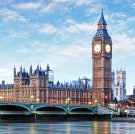Skywatchers across the UK witnessed the Northern Lights for a second consecutive day amidst “breathtaking” levels of solar wind reaching Earth.
The stunning display of lights was also observed in the US and various parts of the northern hemisphere.
On Saturday, some commercial airplanes, including Qatar and Emirates flights to the US west coast, opted for a more southerly route, likely due to the intense solar storms, as reported by Flightradar24.
A geomagnetic storm, triggered by an outburst of plasma from solar wind, could disrupt radio transmissions on Earth and potentially damage satellites in space.
SpaceX chief Elon Musk wrote on X that his Starlink internet satellites were “under a lot of pressure” from the strong magnetic disturbance above Earth caused by the intense solar storm.
“Major geomagnetic solar storm happening right now. Biggest in a long time. Starlink satellites are under a lot of pressure, but holding up so far,” Mr Musk posted on X.
“Those poor ‘Starlink birds’ are slamming on their thrusters right now, fighting to stay in the sky,” Space weather physicist Tamitha Skov posted on X on Saturday.
Northern Lights, also known as aurora borealis, could be spotted in Whitley Bay on the northeast coast, Essex, Cambridgeshire, Liverpool, Kent, Norfolk, with sightings as far south as Sussex on Friday night.
The UK Met Office earlier had also said a strong solar storm would allow northern parts of the UK to see aurora displays for a second night.
The Northern Lights are vibrant curtains of light seen in the night sky, ranging from green to pink and scarlet. They are caused by charged particles from the sun interacting with gases in the Earth’s atmosphere.
The most spectacular displays happen when the sun releases large clouds of particles called “coronal mass ejections [CMEs]”.
Observers from various parts of the world, such as London, Berlin and Switzerland in Europe, and South Dakota, Utah and Mexico in the Americas, as well as from Ladakh in India, shared their photos of the Northern Lights, also known as aurora borealis.
Pictures from different places revealed the aurora in varying colours.
Above the mountainous Ladakh region in India, the skies dazzled in red, likely due to the heating of the atmosphere due to the space weather phenomenon.
“Hanle, Ladakh is seeing auroral arcs, rare for this latitude. These auroral red arcs are likely caused by heating of the atmosphere by electric currents that are circulating between the earth and outer space,” Indian solar physicist Dibyendu Nandi said in a post on X.
“These ring currents get enhanced during geomagnetic disturbances induced by solar storms and thus the likelihood of observing the red auroral arcs are higher at times when we are in the midst of a severe geomagnetic storm such as what we are witnessing now,” Dr Nandi said.
Scientists expect more Northern Lights in the coming days with solar wind activity ramping up.
“The solar wind has systematically ramped up over the weekend and is now clocking at a breathtaking 900 kmps – that’s over 3 million kmph If the other solar magnetic storms arrive at Earth, they are probably going to arrive earlier than anticipated,” Dr Nandi said.
“The space environment is recovering only marginally from yesterday’s intense storm but it remains disturbed; a few more solar storms with southward magnetic field can have a much nastier impact on low earth orbiting satellites,” he added.
Experts suspect more solar storms impacting Earth in the coming days may likely affect satellites in orbit.
“I’ve been hearing a lot of this over the past 24 hours. It will likely get worse before it gets better,” Dr Skov said.
“We are witnessing severe Space Weather at levels we have not seen in the last two decades. It might get worse as more solar storms are expected to impact Earth. Or maybe just more spectacular auroras for all!” Dr Nandi said earlier on Friday.
Source: independent.co.uk



